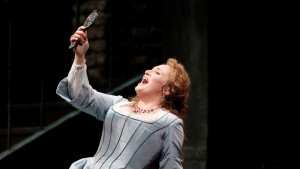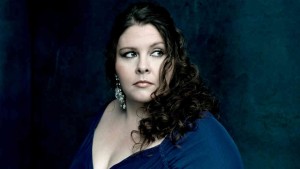 After a couple of initial, lesser attempts, Giacomo Puccini first found his footing in opera with “Manon Lescault,” an adaptation of a popular 19th century novel that had already been made an opera by Massenet a few years earlier.
After a couple of initial, lesser attempts, Giacomo Puccini first found his footing in opera with “Manon Lescault,” an adaptation of a popular 19th century novel that had already been made an opera by Massenet a few years earlier.
Injecting it with his own Italian sensibilities and drama made it a quick hit after its 1893 debut in Turin; it premiered in America a year later. And while it never became the hit of his next three works “La Boheme,” “Tosca” or “Madame Butterfly,” it lay the groundwork for a body of work that balanced beautiful music with a fascination for bewitching women.
In the Washington National Opera production of “Manon Lescault” at the Kennedy Center, one of two operas in repertoire this month, American soprano Patricia Racette makes her debut in the part of the woman attracted by romance, but also by riches.
Seen in the 21st century, it’s amazing how few choices the young woman has when she first appears. Arriving in the busy student town of Amiens in the pre French Revolution 1770s, her father is shipping her off to a convent.
That’s when Renato Des Grieux, a romantic poet who glimpses her, immediately falls in love and plots to abduct her and elope. A rich fellow traveler on the coach, Geronte de Ravoir, also falls for the girl and plans his own abduction. Des Grieux’s achievement is abducting her before Geronte abducts her, but at least she agrees to go with the young man.
A lot of action happens offstage during the first of the two intermissions and the audience must be caught up: Manon and Des Grieux did indeed elope, go to Paris and live together but after living in relative poverty, Manon’s brother Lescaut talks her into hooking up with the rich guy instead.
So Act II opens in his mansion, with Manon luxuriating in its excess. She’s not entirely happy though and when Des Griuex finds her, she begs him to forgive her.
Just as they are about to be found out by Geronte, who has called in the royal guard to capture them, the reunited couple is set to flee, but first Manon wants to grab some of the jewelry. That greed is their undoing and they are caught.
By Act III she is about to be shipped off to a dismal penal colony — America!
Des Grieux, ever the sufferer, first tries to free her before the ship leaves and then begs to be taken along with her.
Following an intermezzo, we find the two have escaped and are on their own and near death on a odd landscape that could only be imagined by an Italian who knew little about the geography of the New World — the deserts surrounding the French possession of New Orleans.
It’s the music and the drama and not necessarily the doomed storytelling that makes great opera, though, and the WNO production abounds in breathtaking sets and costuming — maybe the best anywhere currently on a D.C. stage.
Credit British import John Pascoe for the effect: the production’s director was both set and costume designer. That explains the singular effect of his work.
He begins on the page, literally — in an enlarged scroll onto which projected text sets the scenes (as if the audience isn’t already given all that information and more in their programs). After the page has done its work at the start of the three acts, it splits apart to show the meticulous sets.
Still, the jagged edges of the page never go away, giving some shape to the scenes at their edges, with often another diagonal atop the scenes giving an interesting proscenium space.
Working with a pair of angled two story mirrors stage right, Pascoe creates the busy town square of Amiens that subtly changes in Ruth Hutson’s lighting design from the bright of the afternoon to the richness of dusk, and finally to the twinkle of evening, where stars emerge in the sky to echo the flicker of lanterns placed on the prominent staircase of the inn.
Onto the scene are more than two dozen people at a time, grouped, color-coordinated and presented in a tableaux as if in a Breugel painting. That they get across the stage and interact artfully is likely due to choreographer Diane Coburn Bruning.
The lavish palace of Geronte is a wonder as well, dominated by a large cabinet, in which Manon herself appears at one point, amid the teirras and jewels she loves so well.
The surrounding interior is full of rococo cupids and clouds, also multiplied by the mirrors. The bleak dock scene in Act III is a contrast to all before it; in its dour greasy and the red-tinged setting for their American escape suggests more the Southwest than the lush marshes of Louisiana, but is probably reflective of Puccini’s imagination.
Hairdresser Anne Ford-Coates deserves recognition for her fabulous Louis XIV era wigs with their dramatic horns and powder in the palace.
The cast was strong, with voices soaring at key parts. What more could Racette do with Manon and her inexplicable choices, which changed so much (with her wigs) you almost thought it was a different person each act? Bulgarian tenor Kamen Chanev was powerful as the man stricken with love for her, he had just as many musical high points and blended well with her voice.
Bass-baritone Jake Gardner was a highlight as the elder Geronte and could certainly rock the 18th century wigs.
As a relative opera novice, I’d say the tradition of not amplifying voices meant everything was relatively low volume level, presumably to mix with the orchestra conducted by Philippe Auguin; it could have all been louder. And the use of supertitles high above the action meant those sitting closer to the action were at a disadvantage: they had to keep moving their eyes up from the scenes to see what anyone was saying.
It was amusing during my weeknight performance, to see small groups of people drop out with each intermission, perhaps scared off by premature snow warnings. But Puccini’s “Manon Lescaut” at the Kennedy Center is worth staying with, just as it was worth staying with Puccini through his career.
 A week later, I returned to see Bellini’s “Norma” and learned that some voices don’t need microphones at all.
A week later, I returned to see Bellini’s “Norma” and learned that some voices don’t need microphones at all.
American soprano Angela Meade has sung “Norma” before, in concert settings along her prize-winning ascension into opera’s spotlight.
But the new WNO production allows her to fully embody the role for the first time in the kind of vocal performance that will blow back your hair.
Bel canto was a kind of operatic fad in the early 19th century that was almost too fussy for its own good. If there was an “American Idol” back then, its singers would be criticized for putting too many runs in every melody. Yet Bellini was one of the few composers whose works survived the period because he devised a dramatic reason for his bel canto stars to be singing in such an embellished fashion.
Norma, queen of the Druids, was the kind of overworked managerial woman that continues to get a lot of attention today. How can she rule her people and keep the invading Romans at bay as well as raise her children? She only makes it more difficult by having as a lover Pollione, a leader of the invading Romans.
But there is a new problem, also recognizable in the modern era: He is leaving her for a younger woman, Adalgisa. Norma is mad at this young woman but once she meets her she is so naive and sweet (and doesn’t know that Norma is the wife or even that Pollione is married), she can’t help but develop a fondness for her. More than that, once she learns of the situation, the young woman sides with her and vows to sever ties with him.
Norma is still quite angry, though, and at the outset of Act II is about to do something that does not resonate with audiences now, and I can’t imagine would have ever resonated with audiences: She prepares to kill her children to save them from the ignominy of learning about their father’s true nature.
Killing your own children is the kind of action that pretty much will turn an audience away from you no matter what, and in even considering it, Norma loses us. She tries to get Adalgisa to marry Pollione and go to Rome but she won’t do it. Pollione is brought in as a prisoner and she begs him to come back to her; he still won’t. She then offers a sacrificial victim to get the war going – herself. Pollione then is impressed with her and follows her to the pyre.
Not a great story, but Bellini does a lot with the singing and the changing tone of the lead, wringing every kind of emotion from her along the way, from the famous introductory “Casta diva” that has transcended the work, to the searing duets of Meade with the strong Puerto Rican tenor Rafael Davila and especially that of American mezzo-soprano Dolora Zajick. When those two women begin their soaring, tight harmony, simultaneous runs, conductor Daniele Rustioni stops the orchestra as if they are all just as stunned as the audience.
Another standout at the start and end of the opera is Russian bass Dmitry Belosselskiy as Norma’s father.
That the singing is the true winner in “Norma” shouldn’t be a surprise. But it also makes other aspects of the production pale. Compared to the sumptuous visual feast of “Manon Lescaut,” Neil Patel’s set for “Norma” is static and inert, unchanging for its three hours.
It’s an interesting monochromatic design, with a wall propped with wooden slats on one side and a smooth curving castle wall on the right. In the center of the heavily raked set is a cut out circle, matching an abstract orb on the rear wall.
The black pit looks at first like a perfect Druid worship space when it is unveiled with white-robed dancers around it. Later, it is only as exciting a space as a conversation pit. Finally, just when you think it’s going to be the place where the pyre is going to flame up, alas, the opera ends with Norma walking toward back of the stage, now only lit in red.
The singing is such a big thing in “Norma,” and it takes so much energy, that there is little left over for acting. Director Anne Bogart stands dozens of druids around the set, stock-still. Even when there is interaction between two or three main characters, they all face the audience, as if in concert, and not each other.
James Schuette’s costumes are becoming for the lead women especially, but the lighting by Christopher Akerlind is erratic and can be harsh.
But perhaps singing this vital can overcome all other aspects of the performance. And for that alone, “Norma” will be remembered.
Washington National Opera’s “Manon Lescault” continues at the Kennedy Center through March 23; “Norma” through March 24.